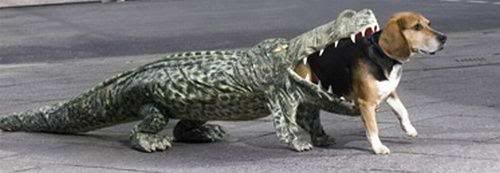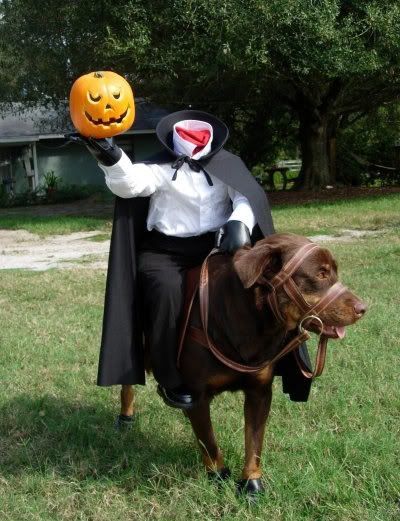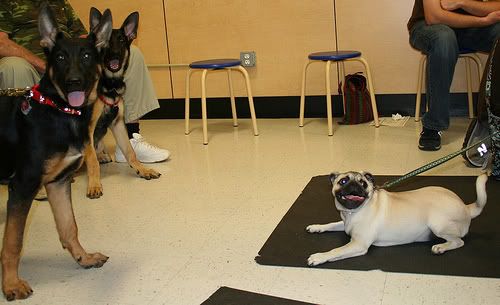Howl-O-Ween can be a frightening and risky holiday for pets but Halloween celebrations can be safe and fun for pets if people are prepared. Pet costumes should be a treat–for the pet.
 Although some pets might like to dress up and participate in events, many more have adverse reactions because pets can get very frightened by costumes and other unusual activities surrounding the Halloween celebrations.
Although some pets might like to dress up and participate in events, many more have adverse reactions because pets can get very frightened by costumes and other unusual activities surrounding the Halloween celebrations.

Recently the Pet Connection posted a link to what was considered some of the best Halloween Pet Costumes. My favorite was the headless horseman.
The alligator pet dog costume that David Schmader liked, looked to be a bit awkward for the dog and the dog didn’t seem to happy about it.
Which brings up a good point–if your pet doesn’t like dressing up–don’t do it.
Also, be careful of the costumes that you do select. They need to allow your pet to breath and shouldn’t be constrictive. So, avoiding pet costumes with masks is generally a good idea.
Dogs are not the only animals that show up for Halloween pet parties but they are certainly the most common pet at these types of events.
Some columnists are making suggestions for home-made pet dog costumes while others are asking if Halloween pet costumes are cute or creepy.
I think the trend is both cute and creepy.
Cute when dogs love it (because they get extra attention) and because they get to get out into public.
I think it is creepy because it shows a lack of understanding about animals.
What do I mean?
People want to connect with animals but don’t really know how to do it. My worry is that in some cases the pets are treated more like live dolls or accessories.
Anyway, Halloween poses some risks to pets. So it is always a good time to remind people what to be aware of and the dangers that may exist during Halloween pet festivities.
The constant door knocking, bell ringing, and unusual appearing guests at your home can stress pets or spook them. This can contribute to escape or aggression so it is best to keep an animal on a leash or safely confined in another room with a nice chew toy.
If you take a dog out with the family to “trick or treat” make sure that you have a reflective collar and leash on the dog. Be alert to the fact that some costumes may really scare your pooch.
Personally, I encourage to keep their pets at home or go to a pet pawty or pet parade specifically for pets.
Okay, I am going to repeat myself a bit but the topic is important so here is a quick list of Halloween pet safety tips:
- Keep animals confined on Halloween. Seclude them safely in a room away from the door and distractions.
- Walk pets before dark to avoid any altercations with costumed characters.
- Vigorous exercise prior to any outings will burn off excess pet energy.
- House animals indoors (especially black ones) just before and during Halloween. This protects pets from pranksters who tease, injure, steal, or kill animals.
- Make sure pets are wearing current identification. Many pets get spooked and escape. Unfortunately they end up in shelters without identification.
- Keep pets away from costumed ghouls and goblins. Halloween bites are not uncommon. Even friendly animals may bite due to stress, fear, or protective aggression.
- Store and dispense candy so that it is not accessible to pets. Many treats are toxic and even lethal to pets.
- Avoid the liability that comes from dressing up your pet and sending the critter out trick-or-treating with kids…always have an adult supervise or keep the animal safely at home.
- Don’t dress up pets unless they love it. If you do dress them up make sure the costume isn’t annoying or unsafe. Avoid restriction of movement, vision, hearing or the ability to breathe, vocalize, or eliminate.
- Costumes should not contain small dangling accessories that could be consumed by the pet or cause choking.
- Restrict your pet’s access to decorations. Jack o’ lanterns with candles are obvious fire hazards, but cats can also get tangled in streamers. Pets can also become ill from eating holiday decor.
Halloween can be fun for all members of your family but avoid scary stories by taking some pet precautions to make it a Happy Howl-o-ween!”


